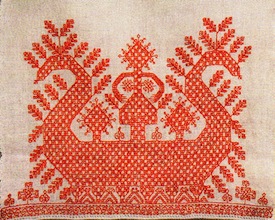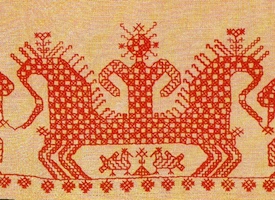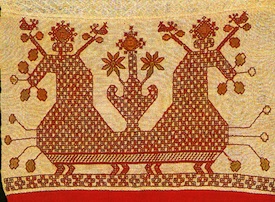
| Embroidery >>> Dictionary of symbols >>> Sun Shallop/Chariot |
|
Sun gods of many Indo-European pantheons were thought as riding a chariot or a boat. Greek Helios, Egyptian Ra, Vedic Indra could be mentioned among them. The most ancient images of The Sun Boat belong to cave paintings founded at Scandinavian Peninsula. A boat depicted there is pulled by a pair of waterfowls, probably, swans.
Slavic myths describe a daytime way of The Sun as an endless circle. During a day, The Sun shines over our land of humans. After sunset, it comes down into an underworld where evil spirits and dead people live. And, The Sun uses two different vehicles for two parts of its journey. It drives a chariot to move around the sky, but, it switches to a boat to float across an underground river. Animals that pull a sun's transport are horses (sometime, winged ones) and swans respectively. Russian traditional crafts expressed the idea of two types of sun's draft animals by inventing fantastic beasts: half-birds, half-horses. For instance, scientists described bone-made talismans depicted ducks with horse's heads. Those figurines were dated as the 11th - 12th century. Also, a decoration of wooden ladles depicted The Sun and birds-horses above it. A village embroidery knows both Boats and Chariots. However, it needs to be noticed that a character driving them is always a female one: The Sun Maiden. The male aspect of The Sun is represented as a divine Rider Dajdbog. A Sun's vehicle is always represented with two heads of appropriate animals on its ends. Scientists tend to explain that in two ways. One theory translates two heads as a symbol of a summer solstice. As a solstice divides a year into two equal parts, The Sun rules both halves. Another point of view deciphered that sign as just a view of a vehicle pulled by two animals. Such an explanation looks reasonable. Making metal or bone-made figurines of The Sun Chariot, Slavs showed two separate animals, not one two-headed fantastic beast.
Being related to The Sun, The Sun Boat/Chariot shares its ability to fertilize the earth and to produce a harvest. Therefore, sometimes a said pictograph has flowers and tree branches growing right from a body of a vehicle. Geographically speaking, The Sun Boat was popular in Northern part of Russia, especially among shoreline's settlers. In Central regions it have been founded rarely, and Southern Russians and Ukrainians did not know it at all. Despite their pagan essence, adapted images of The Sun Chariot ïðîíèêëè into an art of Russian Orthodox Church. They were used as a decorative element in frescos of the famous St.Sophia of Novgorod cathedral (the 9th century) and some smaller churches in Smolensk (the 13th century). Stained glasses of the Church of Accention in Veliky Ustug city depicted a two-head boat carrying The Cross, etc.
|
Sources of Information (in Russian).
|


